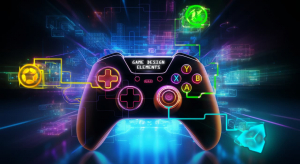Every successful video game features a few common elements- clear goals, surprise elements, a clean core loop, good graphics and sound, and so on. In short, they feature the major game design elements. Game designers follow a combination of certain basic elements to make it memorable. From storyline to mechanics, the focus is to create a well-rounded experience through the game.
Striking the right balance between the game design elements contributes to the game’s ability to engage and immerse players. This is what makes classic games like Pac-Man or Super Mario Bros still playable. Read on to learn all about video game design elements and their importance.
The primary importance of game design is making it memorable, playable, and popular among gamers. Good game design ensures the game attains overall success. It contributes to the fun elements of the game. The game mechanics and design principles can contribute to the players’ experience. When the game’s difficulty level, storyline, and core loop are in sync, it can attract gamers and make the game playable multiple times. A successful game development company providing game design starting with a simple core loop and then branching out into more complex levels. Often there are sub-levels and parallel storylines, depending on the game genre. Successful game design has entrepreneurial importance as well as an entertainment factor. The more entertaining and balanced the gameplay, the higher its profitability will be.

The building blocks of the game contribute to making it engaging, and successful. These are the game design elements. They form the foundation of the game. The following are some of the basic elements of game design:
The first and foremost step is setting a clear objective for the game. This defines the purpose of the video game. A good game will have a clear objective that gets etched in the mind of the gamer right from the beginning. A well-defined objective can motivate players and give a sense of accomplishment to them as they achieve the goal.
The objective of the game can vary depending on the type of game. It can be as simple as reaching the finishing line in racing games or as complex as stopping the end of the world or finding a cure for a disease. A game works out when the objective is challenging but achievable. It should guide the players through the gameplay as well as grasp their attention through the course of the game.
The first step towards setting a clear objective is analyzing the expectations of the target audience. The design and game mechanics will convey the objectives of the video game and accordingly impact the gamer’s psychology.
The restrictions or resistance in the game mechanics adds to the challenge as well as the realism of the game. The pursuit of the game objective would not be as enjoyable if there was no challenge. This is where restraints or restrictions in the game design become crucial. The restrictions in the gameplay are used to create a more challenging game level. The restrictions also often affect the game physics such as the resistance posed by the terrain while the character runs or its sense of direction. The rules and restrictions add more depth to the gameplay. They can come in various forms. Depletion of health when the player falls from a height or increased stamina from specific food- all come under the restriction and rules of game design. Careful implementation of such elements balances the difficulty of the game and makes it engaging.
The interactions between players or the game environment and the players make the gaming experience more engaging. Incorporating interactive elements contributes to the game’s success. Game interaction elements refer to the level of control players have over the environment and the outcome of the game. These factors usually depend on the player’s actions and decisions during gameplay.
The game genre also makes a difference in the level of interactions. For example, a match-3 game like Candy Crush has very simple game mechanics and requires minimal interaction that can contribute to making a difference in how the gameplay progresses. On the other hand, in an RTS game like Age of Empires, the entire gameplay depends on the player’s coordination and decisions.
Game designers include interactivity in a video game to make it more immersive. Interactions can involve a range of actions attributed to the player that allows them to interact with the environment and even NCPs in the game. Constraints, strategic choices, and actions altogether contribute to the interactive quotient of the game. In-game chat options, or the mechanics to interact with fellow players are also types of interactive elements in the game design.

If a game is too easy, players would get bored quickly and breeze through the gameplay- never to replay it again. If a game is too difficult, they would be frustrated even before the game is completed or start looking for cheat codes. The key is to balance the gameplay such that it has the right amount of challenge that motivates the players.
Gameplay balancing mechanics refer to elements that contribute to making the game challenging as well as adding fun factors to the gameplay. These mechanics can be anything ranging from upgraded weapons to bonus levels to maximize the score. The primary idea behind such mechanics is to keep the game interesting and balance the difficulties.
Take the example of a game like BloodRayne where the difficulty progresses with each level. At the same time, the player gets more ammo and upgraded weapons that are designed to tackle the growing challenges. Another example would be Mahjong where players can opt to shuffle the cards once when no other combination is possible.
Inertia refers to the resistance to change that objects and characters in the game may exhibit. It is used as a game design element to make the game more realistic. The implementation of inertia as a game design element is often witnessed in physics-based video games. Players have to take into account the laws of motion and force to progress in such games. The effect of inertia is witnessed in different types of video games like platformers, puzzles, and even RPG and survival games. Inertia affects movements such as jumping or landing where the game character may roll over or move slightly even after you stop pressing the movement button. Another effect of inertia can be the depleted life bar if the player falls off a high place. In short, inertia adds to the challenges of the game that in turn contribute to making it more realistic.
Once you walk into the gaming environment, the progress is not always linear. The storyline has a clear objective but some sub-plots branch out. These add the surprise elements as well as obstacles in the path of reaching the main objective.
Surprises can keep the gamer engaged and hooked. Unpredictable game mechanics, and plot twists all evoke different emotions among the players. These surprises make the game more interesting as the players do not know what to expect at the next level or after the next turn in the game. Such elements are particularly obvious in survival horror games. These elements evoke tension, suspense, and mystery which improves the immersion of the game.
The storyline, script, and sub-plots altogether make the game engaging. The best of classic games are known because of their tight-knit stories. The characters also add to the essence of the game. Take the example of Genshin Impact which has a complex storyline progression with multiple subplots that are often introduced through new characters. As the levels progress, gamers can unlock new characters alongside taking a leap in the storyline or facing plot twists. Also, the background score and music play a crucial role in the gameplay. Sound design can play a very engaging role in the gameplay. With the right soundtrack and music, game designers can improve the gameplay immersion manifolds.
The process of planning and executing the decisions that affect the course of gameplay is referred to as the strategy of the game. Game designers add layers and stages in the game such that the player’s choices affect the direction of the game progression. The series of decisions can be simple or complex that eventually affect the outcome of the game. It is a game design element that creates a sense of ownership among players and engages them. These elements also encourage the critical thinking and problem-solving skills of the players.
The game design elements when balanced correctly, can create a game that will be successful. The popularity of the game depends largely on the balance between the design elements. The above-mentioned are the game design elements that together contribute to the overall quality of the game.
Juego Studios has worked on a wide variety of gaming projects that have gained widespread success. Combining different game design elements in a balanced manner is the key to designing successful games. Get the best game design solutions from top experts, irrespective of game type at our game art studio.